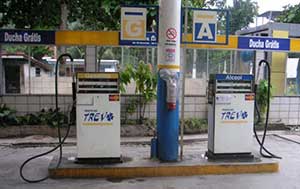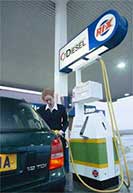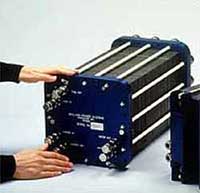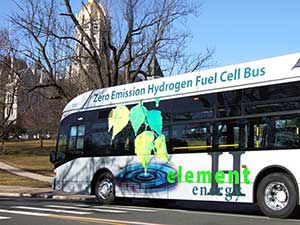Energy-Efficient Vehicles: Alternatives to Gasoline and Electricity
Another route to reducing carbon dioxide (CO2) emissions and increasing energy efficiency is through alternative fuel sources. Ethanol and biodiesel, derived mostly from plant products, are already in use in some parts of the world. Forms of fossil fuels other than gasoline can be more energy efficient and produce less of all of the polluting nitrogen oxide (NOx), sulfur oxide (SOx), and CO2 emissions. Examples of these fuels include cleaner diesel, compressed natural gas, liquefied natural gas, liquefied petroleum gas (propane), and liquids made from coal. Some of these are already in use in limited form. Still in the earliest testing stages is the fuel cell. Fuel cells use hydrogen, which produces only water emissions, however, at present the hydrogen itself is derived from fossil fuels.
|
Ethanol is made from sugar cane at this refinery in Brazil. |
Ethanol and Methanol
One alternative option already in use in parts of the world is ethanol, a biomass fuel. It is made from a starch- or sugar-based crop—such as corn or sugarcane—that is fermented into ethyl alcohol. Because ethanol does not come from petroleum, it does not produce polluting emissions. However, fossil fuels are used in the growing of the crop, in the distilling of the sugar into ethanol, and in the transportation to and from the farm, the plant, and the filling station. Thus this type of fuel is not entirely clean.
Many countries already use ethanol as a fuel additive. However, cars that run on ethanol only are much harder to start in cold weather, which makes them less popular with consumers in colder climates. But in Brazil, where the climate is mild all year, ethanol is an alternative to gasoline. Consumers can select which fuel to use when they pull up to the filling station. All newer vehicles in Brazil are flex-fuel and can run on gasoline, ethanol, or a mixture of the two. Ethanol-powered cars get fewer kilometers per liter (miles per gallon), but the fuel usually costs less than gasoline.
|
Ethanol is made from sugar cane at this refinery in Brazil. Gasoline in left pump; ethanol in right pump. |
When oil prices began to climb in the 1970s, the Brazilian government decided to find a way to become less dependent on oil. The solution: ethanol, from the country’s large crop of sugarcane. This was accomplished over a 30-year span. During that time the government and civilian agencies mandated ethanol use and paid for technological research to make it work as a fuel for vehicles. The government also pushed sugar manufacturers become more efficient by cutting subsidies. Initially, new cars were made to run on ethanol. Then oil prices dropped, so interest in ethanol waned. Two things happened to revive interest in ethanol. First, in the early 2000s, automobile manufacturers developed a way for vehicles to accept either fuel. This was accomplished by a computer program that allows the engine to calculate how to run on whatever mix is in the fuel tank. This makes a car truly flex-fuel. Second, oil prices climbed, reviving interest in cheaper ethanol. The success of ethanol in Brazil has convinced manufacturers in other parts of the world, such as Ford, to develop flex-fuel vehicles.
Sugar has a lot of energy per kilogram (pound). But not all countries are making ethanol from sugar. In the United States, the crop used for ethanol is corn, a starch, which contains less energy per kilogram. India and China are also interested in ethanol as a fuel. India in particular has a significant sugarcane crop. China, like the United States, uses mostly grains. Use of grasses, such as switchgrass, is also under investigation. In these and many other countries, ethanol fuel is under development.
Biodiesel
|
Biodiesel, made from animal fats or plant oils, does not produce polluting emissions. It is in use around the world mixed with diesel automobile fuel or with home heating oil. |
Groups of hydrogen fuel cells, known as a stack, are being tested for use in automobiles. |
Biodiesel is a form of diesel fuel made from fats such as vegetable oil, grease, and animal fats. Like ethanol, biodiesel is considered a biomass fuel that does not produce polluting emissions. Biodiesel can be used in a mix with petroleum-based diesel (which does produce CO2) or on its own. Most biodiesel is used in Germany, but it is available in California as well, among other places. Other countries have also developed interest in this fuel.
Fuel Cells
Hydrogen fuel cells produce electricity through a chemical reaction within the cell. The only by-product of this reaction is water. Hydrogen fuel cells are projected to be a major source of power for vehicles, among other uses, in the future. For now, fuel cells remain experimental, powering buses and other larger vehicles on a limited basis. Honda is planning to introduce the first consumer hydrogen-fuel-cell automobile, the FCX Clarity, in 2009.
The problem with hydrogen as a fuel source is that it requires a new manufacturing and delivery infrastructure. Some of this exists, but most would have to be built. In addition, at this time the most likely source of hydrogen is fossil fuel, so dependency on oil is lessened but not eliminated.
|
In the United States, the state of Connecticut is experimenting with buses powered by fuel cells. |
A number of other issues need to be resolved as well. Fuel cells are far more expensive than internal combustion engines to build and run. Durability and reliability are not yet known, because there is no long-term use history for fuel cells. The size and the weight of a fuel cell system remains an issue as well, because fuel cells take more space than traditional engines. In addition, they may require extra equipment such as processors, fuel tanks, and sensors, taking even more space. Fuel cells also produce a lot of heat, which must be either reused or dissipated somehow.
Fossil-fuel-based Alternatives
Some fossil fuels for vehicles provide more energy per unit than gasoline and diesel do. These include compressed natural gas, liquefied natural gas, and liquefied petroleum gas, more commonly known as propane. Each of these fuels requires either a different engine or modifications of existing engines. These fuels still produce polluting emissions of all types but are more energy efficient than gasoline. Thus they produce fewer pollutants overall.
Cleaner diesel is diesel fuel that has a very low sulfur content. Because of this, cleaner diesel emits much lower amounts of pollutants than older diesel formulations. This type of diesel fuel is now in use worldwide.
Propane is the third-most-used fuel behind gasoline and diesel at this time. It has a relatively high energy density—only about 25% less than gasoline—and burns cleaner. Propane has other uses, among them water heaters, gas stoves, and gas grills, so it is easy to find.
Compressed natural gas (natural gas under high pressure) and liquefied natural gas (very, very cold natural gas that is under high pressure) also burn cleaner than gasoline, thus producing fewer polluting emissions. However, they have lower energy content, so vehicles cannot travel as far on a tankful. Very few vehicles are in production for this type of fuel, but vehicles can be retrofitted. These fuels are used in cars and smaller vehicles (light-duty use) or buses, trucks, and some New York City taxis (heavy-duty).
This content has been re-published with permission from SEED. Copyright © 2025 Schlumberger Excellence in Education Development (SEED), Inc.






